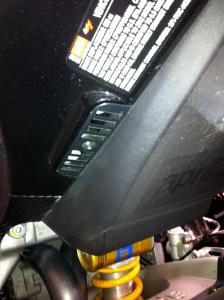The perception of the Husqvarna brand depends a lot on your motorcycle experience and your age. Those into and past their 40s can’t forget the brand’s starring role in the final segment of the iconic On Any Sunday movie, in which Steve McQueen, Malcolm Smith and Mert Lawwill roosted their Husky dirtbikes on a California beach.
But for enthusiasts who are considerably younger, Husqvarna, in business since 1903, is a bit of an enigma. No, the company that makes Husky’s bikes (Husqvarna Motorcycles) doesn’t manufacture chain saws (Husqvarna AB) or sewing machines (VSM Group AB).
The motorcycle division split from its Swedish roots when it was acquired by Cagiva in 1987, later becoming part of MV Agusta S.p.A. Then, in 2007, BMW bought the brand from the Italians, eventually describing the Husky as the two-wheeled version of what the Mini brand is to BMW’s automobile division.
Which brings us to the new TR650, a new platform built around a hot-rodded BMW G650 motor. It’s available in Terra (dual-sport) and Strada (street-biased dual-sport) versions. Impressively, the Terra’s MSRP is just $6999. The Strada, with its standard ABS, costs $500 extra.
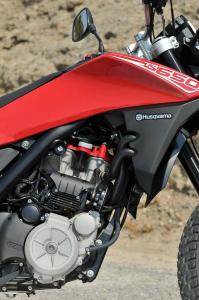 Modifications to the G650’s 652cc Single are extensive. A completely new cylinder head tops off the motor, boasting more efficient flow in and out of the engine through larger intake (38.5 from 36.0mm) and exhaust (34 from 31mm) valves. New camshafts bump the valves more aggressively. The spark plug diameter is smaller, and this is said to more effectively cool the plug area, and the compression ratio gets boosted from 11.5 to 12.3:1.
Modifications to the G650’s 652cc Single are extensive. A completely new cylinder head tops off the motor, boasting more efficient flow in and out of the engine through larger intake (38.5 from 36.0mm) and exhaust (34 from 31mm) valves. New camshafts bump the valves more aggressively. The spark plug diameter is smaller, and this is said to more effectively cool the plug area, and the compression ratio gets boosted from 11.5 to 12.3:1.
Compared to the G650’s 50 crankshaft horsepower at 6500 rpm, the TR650 cranks out a purported 58 ponies at 7250 rpm, a 16% improvement. Both bikes share an identical 44 ft-lb of peak torque, but the TR’s arrives at 5750 rpm instead of the GS’s 5000 revs. Our dyno testing of the BMW revealed 44.2 hp at 7200 rpm, so the TR should produce just over 50 horses at the wheel.
The TR650’s engine feels revvier than the languid version in the G650. Helping quicker rev pickup are lighter internals – a forged piston is 20% lighter than the G’s cast slug, and its crankshaft and balance shaft also receive weight reductions. Although assembly and production of the engine takes place at Loncin in China (as does the G650’s), Husky is keen to note the TR650’s engine “was designed, developed and tested by Husqvarna Motorcycles Italia and BMW Group engineering.”
While the engines are closely related, the TR650’s chassis is unique and uses a bespoke “split backbone” steel frame and swingarm. Suspension components are by Sachs, a 46mm inverted fork up front and a single shock adjustable for preload and rebound damping in back. A fairly generous 7.5 inches of travel soaks up nearly anything you can throw at it. This extra inch or so of suspension travel over the G650 is partially responsible for bumping up the G’s seat height 2.4 inches to the TR650 Strada’s 33.9 inches (Terra: 34.4 inches), so short riders might want to stick with the Beemer.
Italian/Swedish/German Bombs in Andalucía
The Clash’s “Spanish Bombs” was running through my head as I headed off through the Andalucian countryside on Husky’s TR650 a day after riding BMW’s new HP4 at the Jerez race circuit. Combining a BMW launch with a Husky intro was a first for the German parent company.
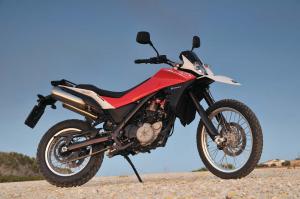 The TR650 makes a strong first impression. It looks far more sleek than the G650, with sharply creased Italian lines coming together to create a harmonious profile. The slanting tank section culminates under the seat in a bold slash, while dual stainless-steel exhaust canisters exit under the pillion section of the seat. The actual fuel tank, as on the G650, is placed under the seat.
The TR650 makes a strong first impression. It looks far more sleek than the G650, with sharply creased Italian lines coming together to create a harmonious profile. The slanting tank section culminates under the seat in a bold slash, while dual stainless-steel exhaust canisters exit under the pillion section of the seat. The actual fuel tank, as on the G650, is placed under the seat.
Behind the trapezoidal headlight and mini flyscreen lays a basic LCD instrument panel that includes two tripmeters and a clock but no gear-position indicator. A nice touch is levers adjustable for reach on both hands. Both the Strada and Terra versions feel moderately tall and exceedingly slim.
We set out first on the dual-sport Terra model, which is easily distinguished from the Strada by its high front fender, spoked wheels and knobby-ish tires. The two TRs also differ in wheel diameters, with the dirt-oriented Terra receiving a 21-inch front and an 18-inch rear in North America. The world-market Terras we sampled are fitted with a 21/17 combo.
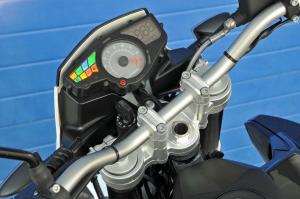 First impressions are of a motor that feels revvier and livelier than the G650’s. Low-end grunt is plentiful, but the counterbalanced mill also tolerates zinging above 6000 rpm when max power is immediately required, with thrust continuing until its 8000-rpm redline. Despite TR’s motor being hotted-up, Husqvarna reps boast a thrifty 58-mpg in real-world mixed riding. The company’s official fuel-economy claim is 4.3 liters per 100 km (55 mpg) on the European driving cycle.
First impressions are of a motor that feels revvier and livelier than the G650’s. Low-end grunt is plentiful, but the counterbalanced mill also tolerates zinging above 6000 rpm when max power is immediately required, with thrust continuing until its 8000-rpm redline. Despite TR’s motor being hotted-up, Husqvarna reps boast a thrifty 58-mpg in real-world mixed riding. The company’s official fuel-economy claim is 4.3 liters per 100 km (55 mpg) on the European driving cycle.
The least impressive part of the powertrain is its 5-speed gearbox. It has a big ratio gap between third and fourth gears that can be awkward out on the road, making us wish it had more even spacing between six, not five, gears. The tranny also isn’t fond of clutchless upshifts.
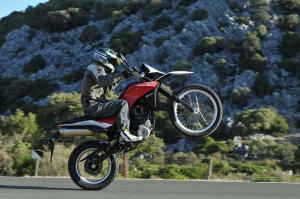 On the road, the TR650 delivers firmer suspension damping than a G650 or a Kawasaki KLR650, delivering admirable control when riding aggressively. Twisty pavement sections were unwound with surprising grace for a machine riding on a 21/17-inch wheel combo with knobby tires, with relatively brisk turn-in response and commendable security when leaned over.
On the road, the TR650 delivers firmer suspension damping than a G650 or a Kawasaki KLR650, delivering admirable control when riding aggressively. Twisty pavement sections were unwound with surprising grace for a machine riding on a 21/17-inch wheel combo with knobby tires, with relatively brisk turn-in response and commendable security when leaned over.
Braking performance is another advantage the TR650s have over most of their rivals. Up front, a radial master cylinder feeds fluid through a braided-steel line to a Brembo 2-piston caliper that bites on a 300mm rotor. They deliver loads of feedback and plenty of power, all without being too abrupt, which is an unwelcome condition when riding off-road.
Our ride route also included a modest amount of dirt riding, and the Terra proved to have an edge over most of its rivals in terms of agility. Scaling in at a claimed 410 pounds with its 3.6-gallon under-seat fuel tank full, the Terra is 13 pounds lighter than the G650GS and 22 pounds lighter than a KLR650, although the latter’s weight includes 2.5 gallons (about 15 lbs) of extra fuel.
The Terra’s Metzeler Enduro 3 Sahara tires seemed to be a good compromise of street/dirt capabilities. The front had good bite in soft sections, but the rear could easily be overwhelmed by big throttle openings.
Strada On The Street
While the Terra is a true dual-sport, the Strada skews the TR650 platform toward the street environment. The key distinction is the choice of wheels and tires – the Strada’s are shorter and wider. Up front, the Strada uses a 110/80-19 instead of the Terra’s 90/90-21. Both rears are 140/80s, but the Strada’s 17-inch diameter is 1 inch smaller than the Terra’s. The rolling stock is the reason the Strada’s seat height is 0.6 inches closer to the ground.
With its 19-inch front wheel (cast aluminum) and non-knobby Tourance EXP tires, the Strada tips into corners a little easier and more fluidly than the Terra, and the suspension’s taut damping held up well to aggressive riding on twisty roads.
Most everything we noted above about the Terra also applies to the Strada. As well, the rider’s saddle has a fairly tight front-to-rear section that restricts positioning for tall riders. I could sit on the pillion portion while still holding on to the bars. The standard ABS on the Strada has a fairly high threshold before intervention and can be disengaged for those who might need or want some rear-wheel lockup.
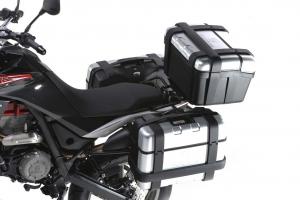 To make the TRs even more versatile, Husqvarna offers a host of optional accessories, including a taller windshield, hand protectors, a lower seat, skid plate and heated grips.
To make the TRs even more versatile, Husqvarna offers a host of optional accessories, including a taller windshield, hand protectors, a lower seat, skid plate and heated grips.
Conclusion
The TR650 is an impressive machine on its own, but it’s the incredibly low MSRPs that make it a standout. At just $6999, the Strada’s list price is just $500 higher than the relatively pedestrian KLR650 and only $600 more than Suzuki’s DR650SE that has roots all the way back into the 1980s. At the other end of the spectrum is KTM's 690R, retailing for $10,299 in 2012.
“It will be our number-one-selling bike,” Kris Odwarka, president, Husqvarna Motorcycles North America, told us, adding the TR650 will greatly expand the appeal of Husqvarna to street riders. Odwarka and his team originally anticipated an 80/20 Terra/Strada mix, but they’ve now revised the balance to 65/35 based on the appeal of the Strada’s standard ABS and its reasonable $7499 MSRP.
Husky’s aggressive pricing on the TRs might even steal sales from BMW’s G650GS, which listed for $7850 in 2012 but includes ABS brakes as standard. The Huskys’ price advantage is offset by a one-year warranty versus the three years on the Beemer, as well as a dealer base that is much more limited than its German parent.
But for enthusiasts who are considerably younger, Husqvarna, in business since 1903, is a bit of an enigma. No, the company that makes Husky’s bikes (Husqvarna Motorcycles) doesn’t manufacture chain saws (Husqvarna AB) or sewing machines (VSM Group AB).
The motorcycle division split from its Swedish roots when it was acquired by Cagiva in 1987, later becoming part of MV Agusta S.p.A. Then, in 2007, BMW bought the brand from the Italians, eventually describing the Husky as the two-wheeled version of what the Mini brand is to BMW’s automobile division.
Which brings us to the new TR650, a new platform built around a hot-rodded BMW G650 motor. It’s available in Terra (dual-sport) and Strada (street-biased dual-sport) versions. Impressively, the Terra’s MSRP is just $6999. The Strada, with its standard ABS, costs $500 extra.
 Modifications to the G650’s 652cc Single are extensive. A completely new cylinder head tops off the motor, boasting more efficient flow in and out of the engine through larger intake (38.5 from 36.0mm) and exhaust (34 from 31mm) valves. New camshafts bump the valves more aggressively. The spark plug diameter is smaller, and this is said to more effectively cool the plug area, and the compression ratio gets boosted from 11.5 to 12.3:1.
Modifications to the G650’s 652cc Single are extensive. A completely new cylinder head tops off the motor, boasting more efficient flow in and out of the engine through larger intake (38.5 from 36.0mm) and exhaust (34 from 31mm) valves. New camshafts bump the valves more aggressively. The spark plug diameter is smaller, and this is said to more effectively cool the plug area, and the compression ratio gets boosted from 11.5 to 12.3:1.Compared to the G650’s 50 crankshaft horsepower at 6500 rpm, the TR650 cranks out a purported 58 ponies at 7250 rpm, a 16% improvement. Both bikes share an identical 44 ft-lb of peak torque, but the TR’s arrives at 5750 rpm instead of the GS’s 5000 revs. Our dyno testing of the BMW revealed 44.2 hp at 7200 rpm, so the TR should produce just over 50 horses at the wheel.
The TR650’s engine feels revvier than the languid version in the G650. Helping quicker rev pickup are lighter internals – a forged piston is 20% lighter than the G’s cast slug, and its crankshaft and balance shaft also receive weight reductions. Although assembly and production of the engine takes place at Loncin in China (as does the G650’s), Husky is keen to note the TR650’s engine “was designed, developed and tested by Husqvarna Motorcycles Italia and BMW Group engineering.”
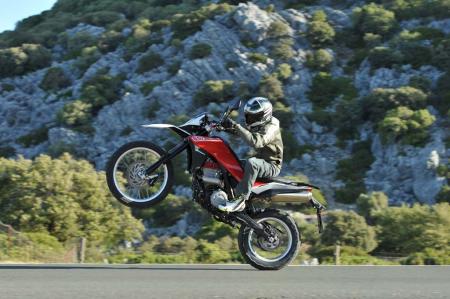 Here’s part of what we mean by “livelier.” Here’s part of what we mean by “livelier.” |
While the engines are closely related, the TR650’s chassis is unique and uses a bespoke “split backbone” steel frame and swingarm. Suspension components are by Sachs, a 46mm inverted fork up front and a single shock adjustable for preload and rebound damping in back. A fairly generous 7.5 inches of travel soaks up nearly anything you can throw at it. This extra inch or so of suspension travel over the G650 is partially responsible for bumping up the G’s seat height 2.4 inches to the TR650 Strada’s 33.9 inches (Terra: 34.4 inches), so short riders might want to stick with the Beemer.
Italian/Swedish/German Bombs in Andalucía
The Clash’s “Spanish Bombs” was running through my head as I headed off through the Andalucian countryside on Husky’s TR650 a day after riding BMW’s new HP4 at the Jerez race circuit. Combining a BMW launch with a Husky intro was a first for the German parent company.
 The TR650 makes a strong first impression. It looks far more sleek than the G650, with sharply creased Italian lines coming together to create a harmonious profile. The slanting tank section culminates under the seat in a bold slash, while dual stainless-steel exhaust canisters exit under the pillion section of the seat. The actual fuel tank, as on the G650, is placed under the seat.
The TR650 makes a strong first impression. It looks far more sleek than the G650, with sharply creased Italian lines coming together to create a harmonious profile. The slanting tank section culminates under the seat in a bold slash, while dual stainless-steel exhaust canisters exit under the pillion section of the seat. The actual fuel tank, as on the G650, is placed under the seat.Behind the trapezoidal headlight and mini flyscreen lays a basic LCD instrument panel that includes two tripmeters and a clock but no gear-position indicator. A nice touch is levers adjustable for reach on both hands. Both the Strada and Terra versions feel moderately tall and exceedingly slim.
We set out first on the dual-sport Terra model, which is easily distinguished from the Strada by its high front fender, spoked wheels and knobby-ish tires. The two TRs also differ in wheel diameters, with the dirt-oriented Terra receiving a 21-inch front and an 18-inch rear in North America. The world-market Terras we sampled are fitted with a 21/17 combo.
 First impressions are of a motor that feels revvier and livelier than the G650’s. Low-end grunt is plentiful, but the counterbalanced mill also tolerates zinging above 6000 rpm when max power is immediately required, with thrust continuing until its 8000-rpm redline. Despite TR’s motor being hotted-up, Husqvarna reps boast a thrifty 58-mpg in real-world mixed riding. The company’s official fuel-economy claim is 4.3 liters per 100 km (55 mpg) on the European driving cycle.
First impressions are of a motor that feels revvier and livelier than the G650’s. Low-end grunt is plentiful, but the counterbalanced mill also tolerates zinging above 6000 rpm when max power is immediately required, with thrust continuing until its 8000-rpm redline. Despite TR’s motor being hotted-up, Husqvarna reps boast a thrifty 58-mpg in real-world mixed riding. The company’s official fuel-economy claim is 4.3 liters per 100 km (55 mpg) on the European driving cycle. The least impressive part of the powertrain is its 5-speed gearbox. It has a big ratio gap between third and fourth gears that can be awkward out on the road, making us wish it had more even spacing between six, not five, gears. The tranny also isn’t fond of clutchless upshifts.
 On the road, the TR650 delivers firmer suspension damping than a G650 or a Kawasaki KLR650, delivering admirable control when riding aggressively. Twisty pavement sections were unwound with surprising grace for a machine riding on a 21/17-inch wheel combo with knobby tires, with relatively brisk turn-in response and commendable security when leaned over.
On the road, the TR650 delivers firmer suspension damping than a G650 or a Kawasaki KLR650, delivering admirable control when riding aggressively. Twisty pavement sections were unwound with surprising grace for a machine riding on a 21/17-inch wheel combo with knobby tires, with relatively brisk turn-in response and commendable security when leaned over. Braking performance is another advantage the TR650s have over most of their rivals. Up front, a radial master cylinder feeds fluid through a braided-steel line to a Brembo 2-piston caliper that bites on a 300mm rotor. They deliver loads of feedback and plenty of power, all without being too abrupt, which is an unwelcome condition when riding off-road.
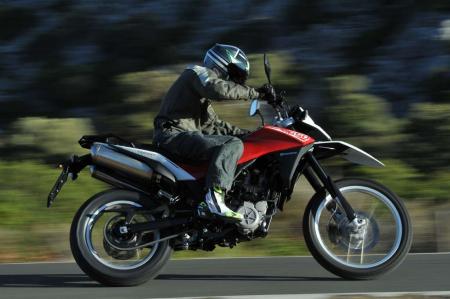 The TR650’s nimbleness and balanced chassis deliver solid on-road performance for a dual-sport. The TR650’s nimbleness and balanced chassis deliver solid on-road performance for a dual-sport. |
Our ride route also included a modest amount of dirt riding, and the Terra proved to have an edge over most of its rivals in terms of agility. Scaling in at a claimed 410 pounds with its 3.6-gallon under-seat fuel tank full, the Terra is 13 pounds lighter than the G650GS and 22 pounds lighter than a KLR650, although the latter’s weight includes 2.5 gallons (about 15 lbs) of extra fuel.
The Terra’s Metzeler Enduro 3 Sahara tires seemed to be a good compromise of street/dirt capabilities. The front had good bite in soft sections, but the rear could easily be overwhelmed by big throttle openings.
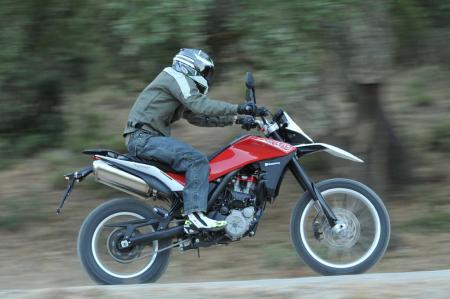 The Terra’s only real ergonomic shortcoming is handlebars placed too close to a rider in a standing position. However, we found out after our ride the handlebar mounts can be flipped to alter the position of the bars. The Terra’s only real ergonomic shortcoming is handlebars placed too close to a rider in a standing position. However, we found out after our ride the handlebar mounts can be flipped to alter the position of the bars. |
Strada On The Street
While the Terra is a true dual-sport, the Strada skews the TR650 platform toward the street environment. The key distinction is the choice of wheels and tires – the Strada’s are shorter and wider. Up front, the Strada uses a 110/80-19 instead of the Terra’s 90/90-21. Both rears are 140/80s, but the Strada’s 17-inch diameter is 1 inch smaller than the Terra’s. The rolling stock is the reason the Strada’s seat height is 0.6 inches closer to the ground.
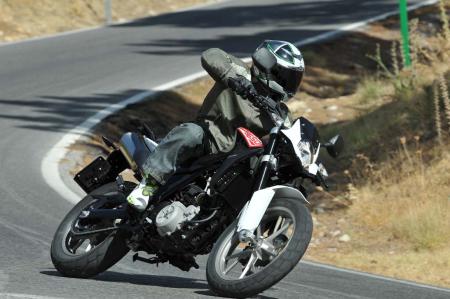 Husky’s TR650 Strada is a joy to throw around on a tight, sinuous road. Husky’s TR650 Strada is a joy to throw around on a tight, sinuous road. |
With its 19-inch front wheel (cast aluminum) and non-knobby Tourance EXP tires, the Strada tips into corners a little easier and more fluidly than the Terra, and the suspension’s taut damping held up well to aggressive riding on twisty roads.
Most everything we noted above about the Terra also applies to the Strada. As well, the rider’s saddle has a fairly tight front-to-rear section that restricts positioning for tall riders. I could sit on the pillion portion while still holding on to the bars. The standard ABS on the Strada has a fairly high threshold before intervention and can be disengaged for those who might need or want some rear-wheel lockup.
 To make the TRs even more versatile, Husqvarna offers a host of optional accessories, including a taller windshield, hand protectors, a lower seat, skid plate and heated grips.
To make the TRs even more versatile, Husqvarna offers a host of optional accessories, including a taller windshield, hand protectors, a lower seat, skid plate and heated grips. Conclusion
The TR650 is an impressive machine on its own, but it’s the incredibly low MSRPs that make it a standout. At just $6999, the Strada’s list price is just $500 higher than the relatively pedestrian KLR650 and only $600 more than Suzuki’s DR650SE that has roots all the way back into the 1980s. At the other end of the spectrum is KTM's 690R, retailing for $10,299 in 2012.
“It will be our number-one-selling bike,” Kris Odwarka, president, Husqvarna Motorcycles North America, told us, adding the TR650 will greatly expand the appeal of Husqvarna to street riders. Odwarka and his team originally anticipated an 80/20 Terra/Strada mix, but they’ve now revised the balance to 65/35 based on the appeal of the Strada’s standard ABS and its reasonable $7499 MSRP.
Husky’s aggressive pricing on the TRs might even steal sales from BMW’s G650GS, which listed for $7850 in 2012 but includes ABS brakes as standard. The Huskys’ price advantage is offset by a one-year warranty versus the three years on the Beemer, as well as a dealer base that is much more limited than its German parent.
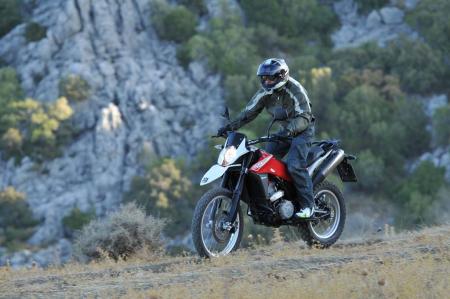 Husqvarna’s pair of TR650 models livens up the Big Thumper dual-sport category with a winning combination of European design and modest prices. Husqvarna’s pair of TR650 models livens up the Big Thumper dual-sport category with a winning combination of European design and modest prices. |



 22:56
22:56
 Unknown
Unknown


 Posted in:
Posted in: 
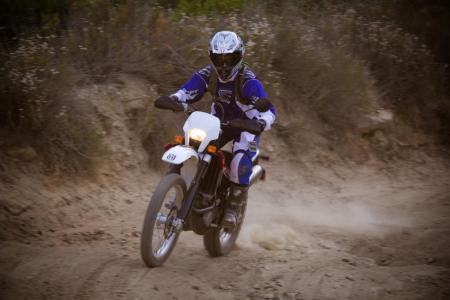 With a number of useful updates for 2012, like firmer suspension settings, a new shock, and a stiffer frame, the TE excels in the dirt and on trails – from tip to tail it communicates an overall taut, athletic-feeling ride.
With a number of useful updates for 2012, like firmer suspension settings, a new shock, and a stiffer frame, the TE excels in the dirt and on trails – from tip to tail it communicates an overall taut, athletic-feeling ride.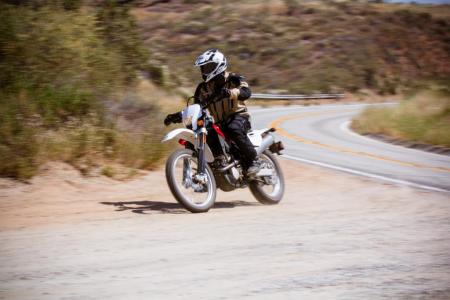 The perfect transition for this 250 dual-sport: street to dirt.
The perfect transition for this 250 dual-sport: street to dirt.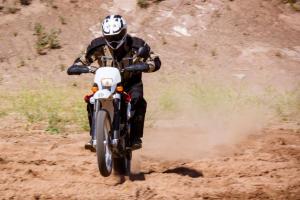
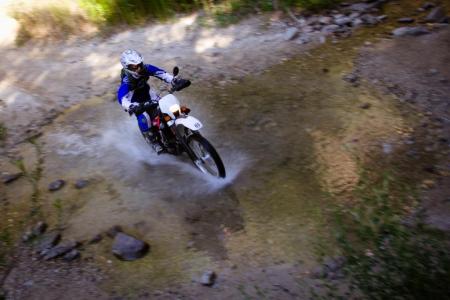 Although licensed for riding in the street, the TE250 is up for just about any off-road challenge you can throw its way.
Although licensed for riding in the street, the TE250 is up for just about any off-road challenge you can throw its way.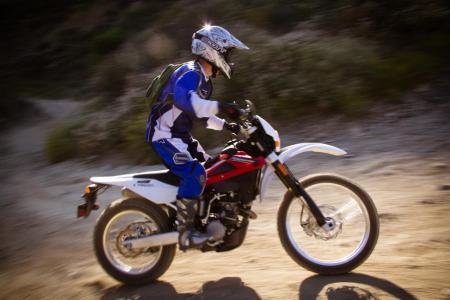 If you’re in the market for a lightweight dual-sport with the off-road chops to tackle the really rough stuff, then consider the 2012 Husqvarna TE250: it’s the most off-road capable motorcycle the 250cc dual-sport class has to offer.
If you’re in the market for a lightweight dual-sport with the off-road chops to tackle the really rough stuff, then consider the 2012 Husqvarna TE250: it’s the most off-road capable motorcycle the 250cc dual-sport class has to offer.
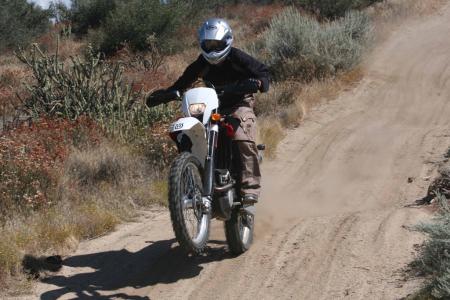 Newest of the Husky dual-sports is the TE250, now with shorter suspension and a 2-inch lower seat height to make it more palatable for commuter duties.
Newest of the Husky dual-sports is the TE250, now with shorter suspension and a 2-inch lower seat height to make it more palatable for commuter duties. 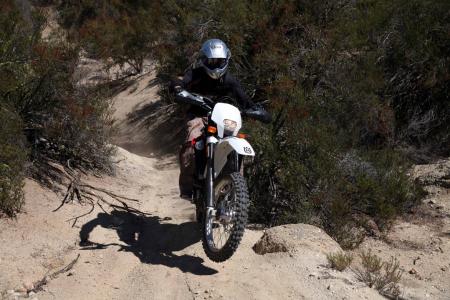 The TE250 is very nimble, and it does well off-road despite its shorter suspension.
The TE250 is very nimble, and it does well off-road despite its shorter suspension. 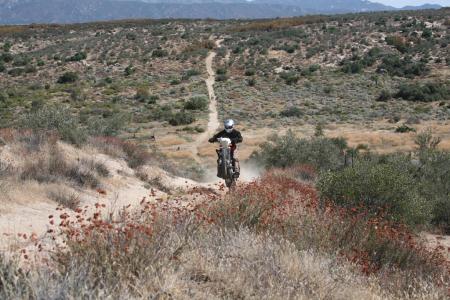 When the pavement ends, the TE250 keeps on truckin’.
When the pavement ends, the TE250 keeps on truckin’. 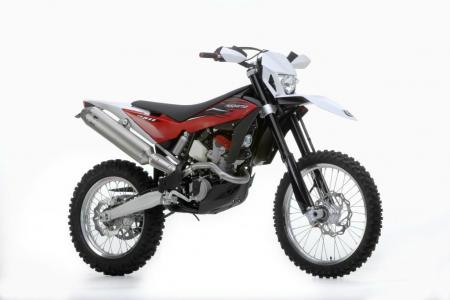 The TE511 is Husky’s biggest dual-sport, but don’t let its name mislead you. Its engine displaces an actual 478cc, not 510 of them.
The TE511 is Husky’s biggest dual-sport, but don’t let its name mislead you. Its engine displaces an actual 478cc, not 510 of them. 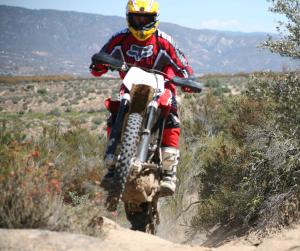
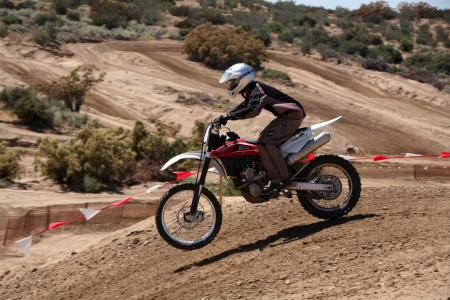 It was fun to toss around the TXC310 on the undulating layout of the Carlsbad-replica MX track at The Ranch in Anza, California.
It was fun to toss around the TXC310 on the undulating layout of the Carlsbad-replica MX track at The Ranch in Anza, California. 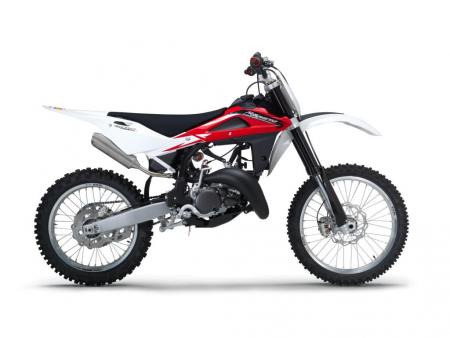 Husky’s CR125 two-stroke is incredibly light, weighing just 203 pounds. A 144cc big-bore kit is included at no extra charge.
Husky’s CR125 two-stroke is incredibly light, weighing just 203 pounds. A 144cc big-bore kit is included at no extra charge. 
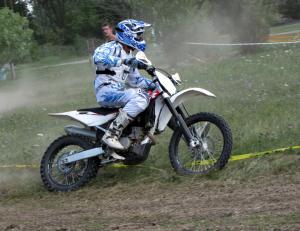
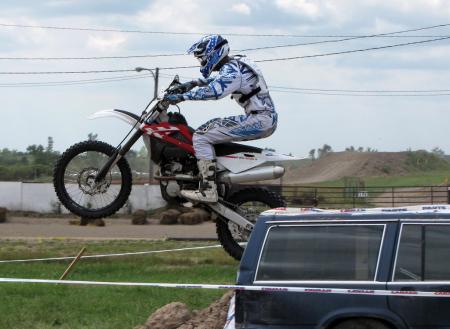 Our biggest complaint about the TXCi was its fork performance, feeling both overdamped and undersprung.
Our biggest complaint about the TXCi was its fork performance, feeling both overdamped and undersprung.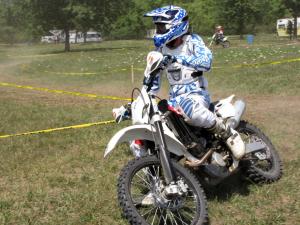
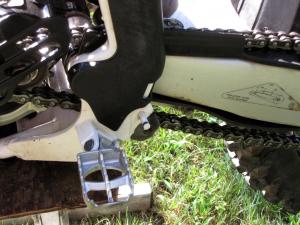
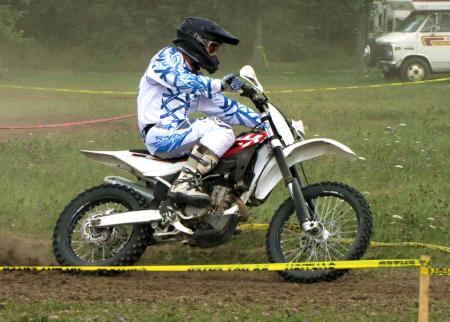 We had fun racing our TXCi on grass tracks, where the smooth powerband, excellent brakes and lightweight feel helped it turn great lap times.
We had fun racing our TXCi on grass tracks, where the smooth powerband, excellent brakes and lightweight feel helped it turn great lap times.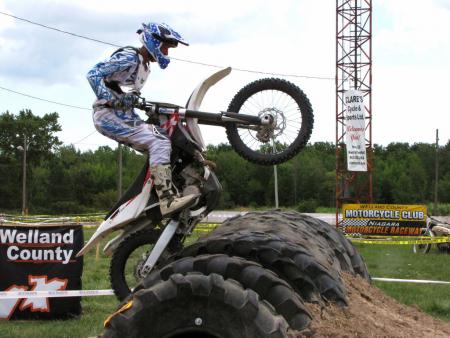 The clutch feel and transmission are great, but a few more teeth on the rear sprocket would certainly make the bike easier to ride. Thanks to the six-speed transmission we’d gladly trade some top-end speed for less clutch abuse in technical sections.
The clutch feel and transmission are great, but a few more teeth on the rear sprocket would certainly make the bike easier to ride. Thanks to the six-speed transmission we’d gladly trade some top-end speed for less clutch abuse in technical sections.
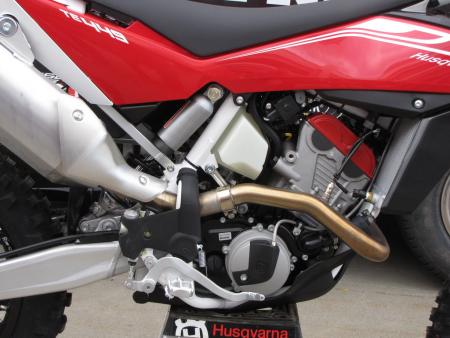 Recognize this? It’s a hot-rodded, evolved version of the EFI 450 engine BMW has been successfully racing internationally in Enduro events. We didn’t get a chance to ride this pre-production model but are pulling every string possible to get our hands on one as soon as possible!
Recognize this? It’s a hot-rodded, evolved version of the EFI 450 engine BMW has been successfully racing internationally in Enduro events. We didn’t get a chance to ride this pre-production model but are pulling every string possible to get our hands on one as soon as possible!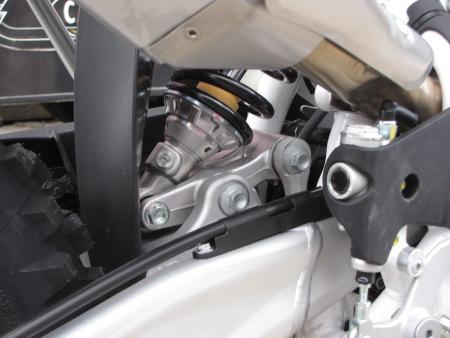 The Husky retains BMW’s countershaft sprocket location, which is inline with the swingarm pivot to maximize traction. One thing we didn’t like about the Beemer that Husky has fixed was the no-link rear suspension. The top-mounted linkage is up out of the mud, and is equipped with grease fittings to simplify maintenance!
The Husky retains BMW’s countershaft sprocket location, which is inline with the swingarm pivot to maximize traction. One thing we didn’t like about the Beemer that Husky has fixed was the no-link rear suspension. The top-mounted linkage is up out of the mud, and is equipped with grease fittings to simplify maintenance!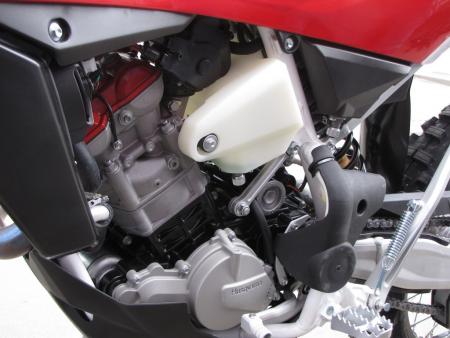 Like the BMW G450X, the Husky’s fuel tank is under the seat. Unlike the BMW, the tank is clear allowing the rider to check fuel level. The gas cap location has been moved as well, further toward the back of the bike where it can’t contact the rider.
Like the BMW G450X, the Husky’s fuel tank is under the seat. Unlike the BMW, the tank is clear allowing the rider to check fuel level. The gas cap location has been moved as well, further toward the back of the bike where it can’t contact the rider. 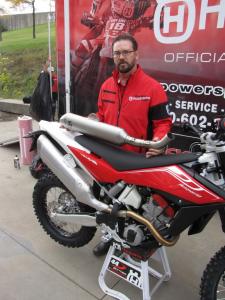

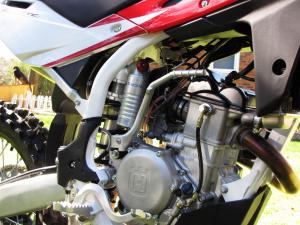
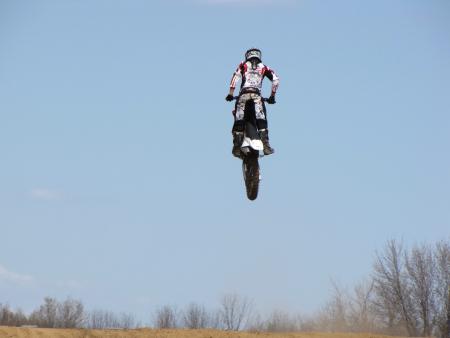 South African MX Pro Liam O’Farrell was stoked at how confidence inspiring the new machine feels in the air.
South African MX Pro Liam O’Farrell was stoked at how confidence inspiring the new machine feels in the air.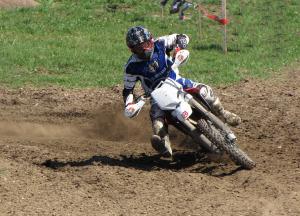
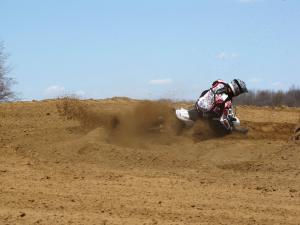
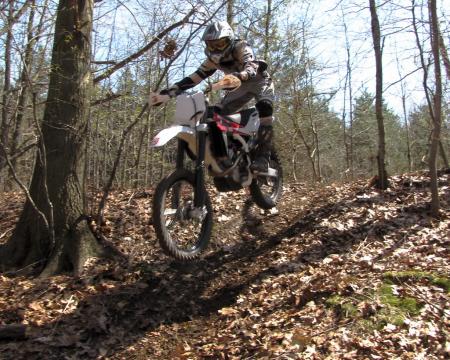 It’s a motocross bike, but where the Husky TC 250 really excels is woods racing.
It’s a motocross bike, but where the Husky TC 250 really excels is woods racing.


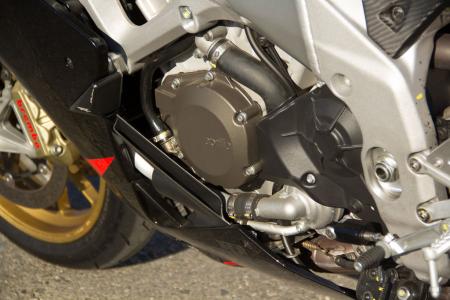 The same basic 65-degree, 999cc V-Four engine is shared between the Factory and R models, but the former benefits from adjustable intake stacks and magnesium covers to increase power and shave weight.
The same basic 65-degree, 999cc V-Four engine is shared between the Factory and R models, but the former benefits from adjustable intake stacks and magnesium covers to increase power and shave weight.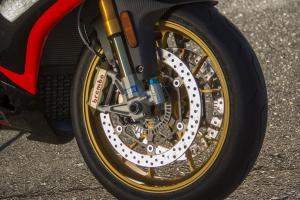
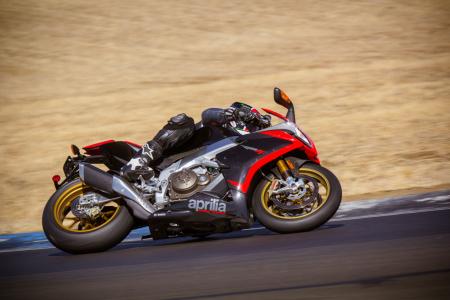 Attacking corners on the racetrack is where the RSV4 Factory feels most at home.
Attacking corners on the racetrack is where the RSV4 Factory feels most at home.